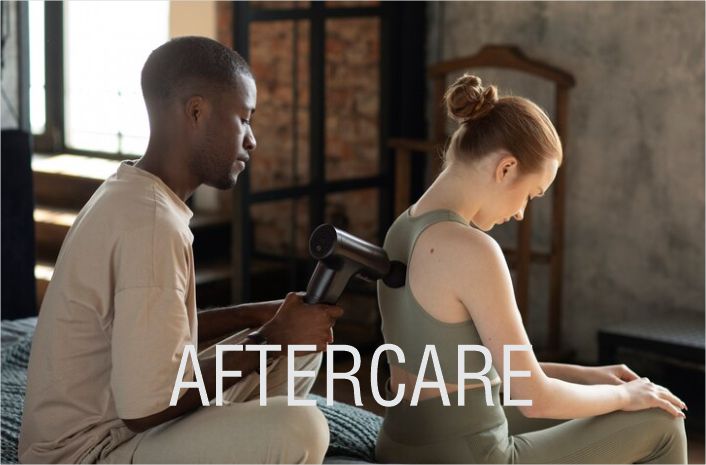Discover why aftercare in BDSM practice is important, ensuring emotional security, trust, and well-being for both dominants and submissives after play.
You just had an intense BDSM scene, your heart’s still racing, your body buzzing with sensation. What happens next?
That’s where aftercare comes in. It’s not just a nice extra; it’s a key part of the experience. Aftercare helps you and your partner come down safely, easing physical strain, balancing emotions, and reinforcing trust.
It can be as simple as a blanket, water, or quiet reassurance. Without it, you risk emotional drops or misunderstandings.
BDSM isn’t just about the highs; it’s about how you land. Prioritizing aftercare keeps your dynamic strong, safe, and fulfilling for both you and your partner.
Table of Contents
- What is Aftercare in BDSM?
- Why Aftercare Matters
- Types of Aftercare
- Communicating About Aftercare
- Aftercare for Dominants and Submissives
- Addressing Subdrop and Topdrop
- Customizing Aftercare for Different Dynamics
- Final Thoughts
What is Aftercare in BDSM?
Aftercare is the emotional and physical support partners provide to each other after a BDSM scene. It helps ease the transition from an intense experience back to everyday life, reinforcing trust and emotional well-being.
Depending on the scene, aftercare can involve comforting touch, hydration, verbal reassurance, or simply quiet time together.
BDSM often involves heightened emotions, deep vulnerability, and strong physical sensations.
Without proper aftercare, a participant may feel disconnected, overwhelmed, or even experience a “drop”, a sudden emotional low after an intense high. Aftercare ensures both partners feel supported, respected, and safe post-play.
Recommended: The Importance of Safe Words
Why Aftercare Matters
BDSM is built on trust, communication, and mutual consent. Aftercare plays a key role in maintaining this foundation by:
- Supporting Emotional Recovery: Scenes can trigger deep emotions, and aftercare helps process these feelings in a safe environment.
- Ensuring Physical Well-being: Some activities leave marks or cause exhaustion; tending to hydration, bruises, or muscle soreness is essential.
- Reaffirming Connection: Aftercare reassures both partners of their bond and mutual respect, strengthening the dynamic.
Neglecting aftercare in BDSM can lead to emotional distress, miscommunication, or long-term dissatisfaction in BDSM relationships. Prioritizing post-scene care deepens trust and enhances future experiences.
Related: Why Consent Matters in BDSM
Types of Aftercare
Aftercare in BDSM isn’t one-size-fits-all. It varies based on individual needs, scene intensity, and relationship dynamics. Common types include:
1. Physical Aftercare
- Hydration (water, electrolyte drinks, or tea)
- Cuddling, blankets, or body warmth to restore comfort
- Checking for bruises, rope marks, or soreness and applying care (ice packs, arnica, or massage)
- Rest, allows the body to recover
2. Emotional Aftercare
- Verbal reassurance (expressing care, appreciation, and encouragement)
- Active listening, allowing both partners to share post-scene thoughts and feelings
- Affirmations of trust and positive reinforcement to avoid negative self-talk or doubts
- Giving space if needed, respecting different emotional recovery styles
3. Mental Aftercare
- Grounding techniques (deep breathing, mindfulness, or gentle movement)
- Reviewing boundaries and limits to reinforce a sense of control
- Journaling or debriefing to process the scene’s impact
- Watching a comfort movie, reading, or engaging in a soothing activity
Each individual responds to BDSM differently. Discussing and adjusting aftercare to fit specific needs creates a healthier, more fulfilling dynamic.
Related: How to Start BDSM as a Beginner
Communicating About Aftercare
Open discussion about aftercare should happen before a scene, not just after. This ensures both partners understand each other’s expectations and can prepare accordingly.
Key Questions to Ask:
- What kind of aftercare do you need to feel safe and grounded?
- Do you prefer physical touch, verbal reassurance, or space after a scene?
- Are there specific things that help you recover emotionally and physically?
- How long do you typically need aftercare? Immediate, prolonged, or check-ins later?
Encouraging honest feedback after a scene helps refine aftercare practices over time, making future experiences even better.
Further Reading: Introducing BDSM to Your Partner
Aftercare for Dominants and Submissives
Aftercare isn’t just for submissives—dominants also need support. While submissives may experience physical exhaustion or emotional vulnerability, dominants might feel guilt, responsibility, or an adrenaline crash.
Dominant Aftercare Needs:
- Verbal affirmation that the scene was enjoyed and consensual
- Physical affection, such as cuddling or a simple touch
- Space to decompress and process emotions
- Hydration and rest
- Reassurance that they met their partner’s needs
Submissive Aftercare Needs:
- Emotional validation and reassurance
- Physical care for any marks or soreness
- A safe space to express feelings
- A comforting routine, such as a warm drink or soft music
Recognizing that both partners benefit from aftercare fosters a balanced, healthy BDSM relationship.
Related: Want to Take the BDSM Test and Quiz?
Addressing Subdrop and Topdrop
“Subdrop” refers to the emotional crash a submissive may feel hours or even days after a scene.
Symptoms can include mood swings, fatigue, sadness, or feelings of detachment. Long-term aftercare, such as check-ins, emotional support, and reassurance, helps manage sub-drop effectively.
“Topdrop” is less discussed but equally valid. Dominants may feel guilt, exhaustion, or self-doubt post-scene. Encouraging dialogue, receiving reassurance from their partner, and engaging in self-care can help mitigate this.
Customizing Aftercare for Different Dynamics
Every BDSM dynamic requires unique aftercare. Whether engaging in casual play, long-term relationships, or polyamorous arrangements, aftercare should be tailored accordingly.
Casual or One-Time Play
- Discuss expectations beforehand
- Keep aftercare simple but effective (hydration, reassurance, a check-in later)
- Respect boundaries and emotional responses
Long-Term Relationships
- Develop consistent aftercare routines
- Maintain open communication about evolving needs
- Offer continued emotional and mental support
Online or Long-Distance BDSM
- Utilize video calls or voice messages for verbal aftercare
- Text check-ins over hours or days
- Plan in-person visits with aftercare in mind
By personalizing aftercare, BDSM practitioners create healthier, more fulfilling dynamics.
Final Thoughts
Aftercare isn’t just an option, it’s a responsibility. It strengthens relationships, safeguards emotional well-being, and ensures a positive BDSM experience.
Whether through physical comfort, emotional reassurance, or open communication, prioritizing aftercare reflects mutual respect and care.
By integrating thoughtful aftercare into BDSM practice, you create a safer, more connected, and enjoyable experience for everyone involved.

